Author: Brian Hall
It’s commonly said that brewers make wort while yeast make beer, and as any brewer knows, there are various types of yeast available that produce different characteristics. With beer commonly referred to as “liquid bread,” perhaps it’s unsurprising that the yeast strain associated with ales, Saccharomyces cerevisiae, is the same that’s used in baking.
In both brewing and baking, yeast metabolizes available sugars, producing both alcohol and carbon dioxide (CO2), the latter of which causes dough to rise prior to baking. However, despite their similarities, people are advised to avoid using bakers yeast to ferment beer because it can lead undesirable off-flavors. The reason brewers yeasts work so well is that they’ve been cultivated for hundreds of years to produce the specific characteristics expected in beer.
I love baking and eating bread nearly as much as I love brewing and drinking beer. In my nearly 20 years of homebrewing, I’ve experimented with some weird stuff including making beer with a sourdough starter, but I’ve never tried fermenting with baker’s yeast largely because of recommendations not to. Of course, when someone tells me not to do something, the experimenter in me says I should try it out.
| PURPOSE |
To evaluate the differences between an beers fermented with wither Fleischmann’s Active Dry Yeast or Safale US-05 American Ale Yeast.
| METHODS |
The recipe for this xBmt was inspired by Tiny Bottom Pale Ale, which I felt was simple enough to allow any differences caused by the yeast to be apparent.
Liquid Loaf
Recipe Details
| Batch Size | Boil Time | IBU | SRM | Est. OG | Est. FG | ABV |
|---|---|---|---|---|---|---|
| 5.5 gal | 60 min | 36.6 IBUs | 9.1 SRM | 1.054 | 1.012 | 5.6 % |
| Actuals | 1.054 | 1.009 | 5.9 % | |||
Fermentables
| Name | Amount | % |
|---|---|---|
| Lamonta American-style Pale Malt (Mecca Grade) | 8.5 lbs | 77.27 |
| Caramel/Crystal Malt - 15L | 12 oz | 6.82 |
| Vanora Vienna-style Malt (Mecca Grade) | 12 oz | 6.82 |
| Victory Malt | 10 oz | 5.68 |
| Caramel/Crystal Malt - 60L | 6 oz | 3.41 |
Hops
| Name | Amount | Time | Use | Form | Alpha % |
|---|---|---|---|---|---|
| Magnum | 16 g | 60 min | Boil | Pellet | 11.6 |
| Perle | 14 g | 25 min | Boil | Pellet | 8.6 |
| Fuggles | 14 g | 10 min | Boil | Pellet | 4.4 |
| Fuggles | 15 g | 2 min | Boil | Pellet | 4.4 |
Yeast
| Name | Lab | Attenuation | Temperature |
|---|---|---|---|
| Safale US-05 OR Fleischmann's Active Dry Yeast | 77% | 59°F - 75°F |
Notes
| Water Profile: Ca 126 | Mg 0 | Na 0 | SO4 118 | Cl 135 |
Download
| Download this recipe's BeerXML file |
With the brewing water collected and adjusted it to my desired profile, I lit the flame under the kettle then milled the grain.
When the water was adequately heated, I stirred in the grist then checked to make sure it hit my target mash temperature.
Following a 60 minute mash rest, I sparged to collect the expected pre-boil volume of sweet wort then brought it to a rolling boil.
After the 60 minute boil, I quickly chilled the wort before taking a hydrometer measurement showing it was at the target OG.
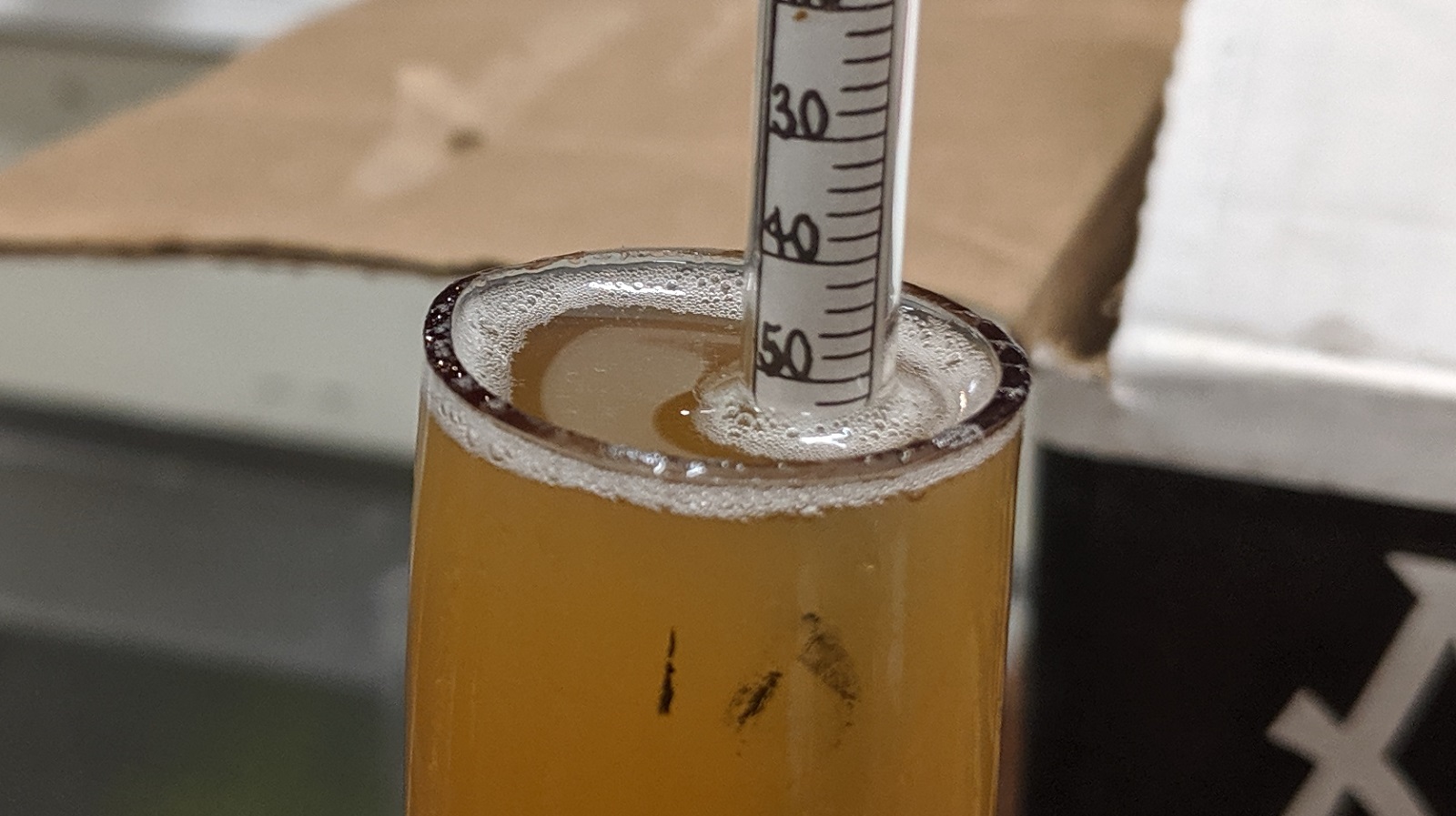
The wort was evenly split between two sanitized carboys that were placed next to each other in my garage that maintains 64-66°F/18-19°C.
At this point, I rehydrated 2 packs each of Fleischmann’s Active Dry Yeast and Safale US-05 in 75 mL of tepid water for 10 minutes before pitching.
I left the beers alone for 10 days before taking hydrometer measurements showing the beer fermented with baker’s yeast attenuated a bit more than the one fermented with brewer’s yeast.
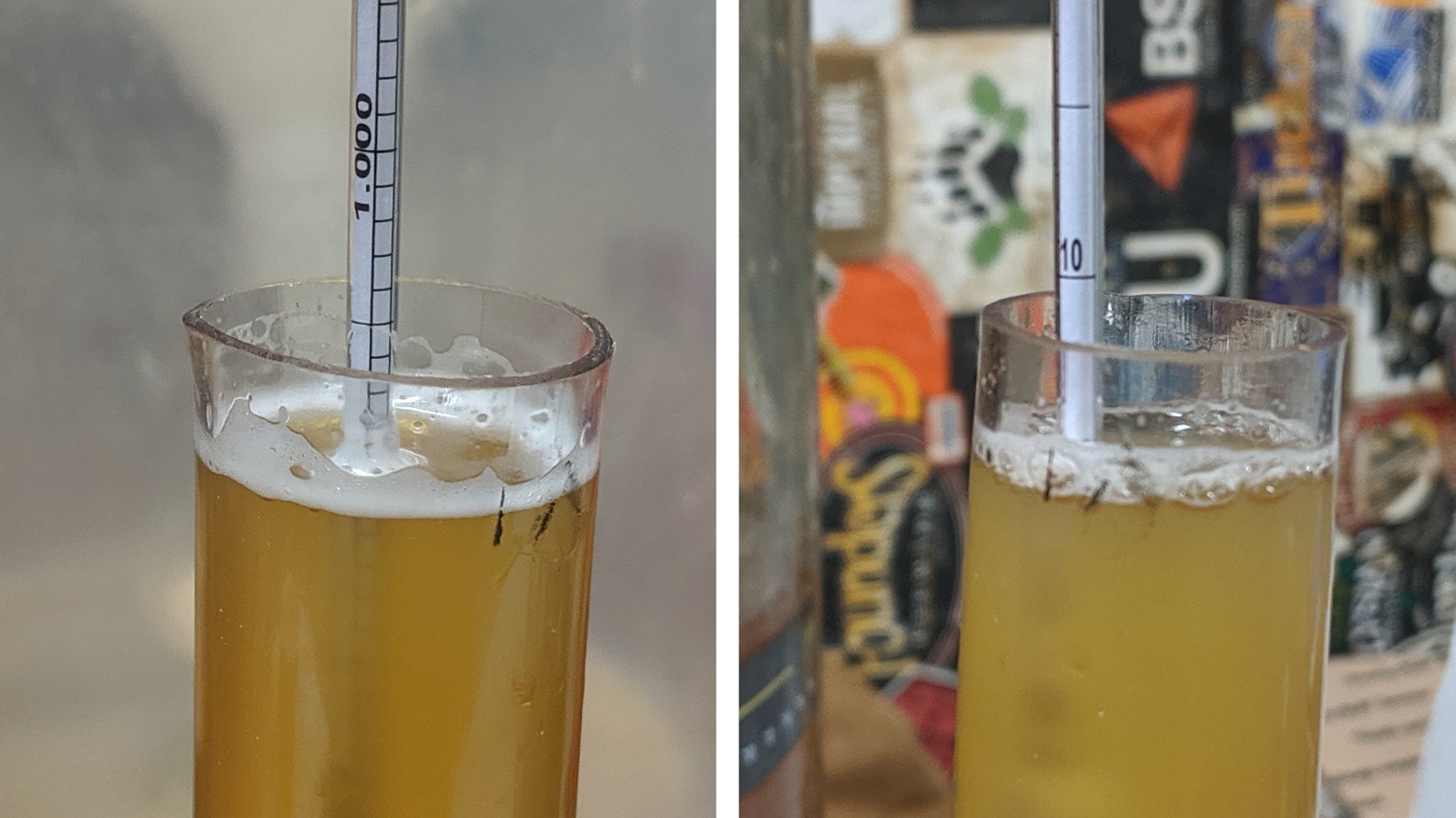
The beers were racked to separate kegs that were placed in my keezer, burst carbonated, then left to condition for a week before I began serving them to tasters.
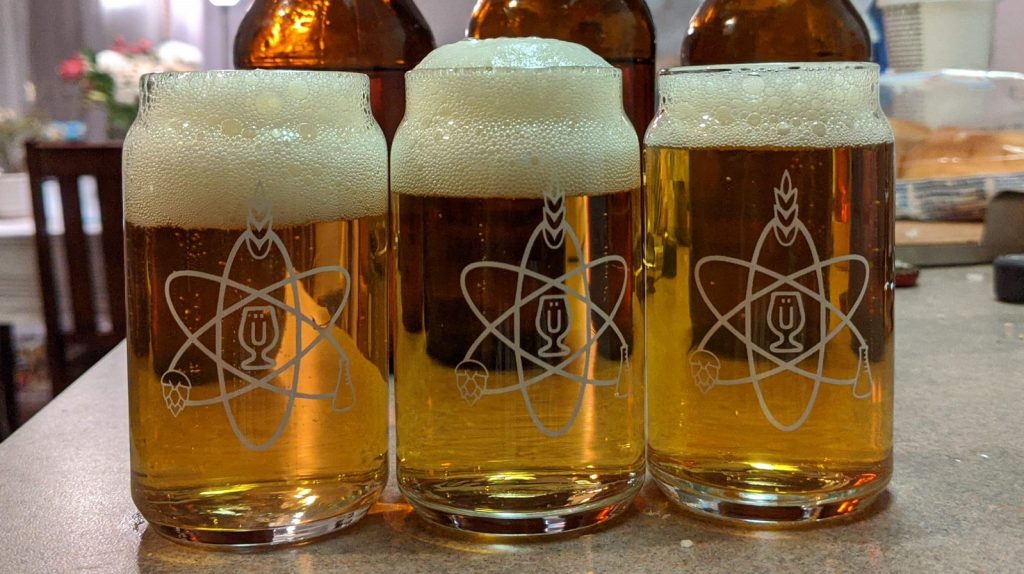
| RESULTS |
A total of 20 people of varying levels of experience participated in this xBmt. Each participant was served 2 samples of the beer fermented with Fleischmann’s Active Dry Yeast and 1 sample of the beer fermented with Safale US-05 American Ale yeast in different colored opaque cups then asked to identify the unique sample. While 11 tasters (p<0.05) would have had to accurately identify the unique sample in order to reach statistical significance, 12 (p=0.013) did, indicating participants in this xBmt were able to reliably distinguish a Pale Ale fermented with baker’s yeast from one fermented with Safale US-05 brewer’s yeast.
The 12 participants who made the accurate selection on the triangle test were instructed to complete a brief preference survey comparing only the beers that were different. A total of 4 tasters reported preferring the beer fermented with baker’s yeast, 7 liked the brewer’s yeast beer more, and 1 had no preference despite noticing a difference.
My Impressions: I performed a number of semi-blind triangle tests and was consistently able to identify the odd-beer-out each time. To my palate, the beer fermented with Safale US-05 was a bit muddled with lacking enthusiasm while the one fermented with baker’s yeast tasted more like a poorly executed Belgian ale– I actually entered it as a Trappist Single in a competition and it scored in the low 30’s. Ha!
| DISCUSSION |
It’s well-known that various strains of yeast produce unique characteristics when used to ferment beer, despite being of the same species. Through centuries of cultivation and selective breeding, numerous types of Saccharomyces cerevisiae, aka brewer’s yeast, exist that allow for brewing of myriad styles ranging from banana-forward Hefeweizen to clean Pale Ale. While the yeast used in baking is also S. cerevisiae and can ferment beer, it’s commonly said that using it for such can lead to undesirable off-flavors. The fact tasters in this xBmt were able to reliably distinguish beers fermented with either Fleischmann’s Active Dry baker’s yeast or the popular Safale US-05 American Ale yeast suggests each strain imparted unique characteristics.
The data collected for this xBmt doesn’t allow us to comment on what exactly it was about the beers that made them noticeably different, but based on the conversations I had with tasters who’d completed the survey, the baker’s yeast beer seemed to have a phenolic note that was absent in the one fermented with Safale US-05. Interestingly, 1/3 of the participants who were correct on the triangle test preferred the beer fermented with bread yeast.
Given the abundance and variety of quality brewer’s yeast these days, as well as my personal disliking of the beer fermented with baker’s yeast in this xBmt, I won’t be changing my fermentation practices any time soon. However, in the event of an apocalypse, I’d definitely reserve some Fleischmann’s for liquid sustenance, though I’d probably stick to more phenol-forward Belgian ale in that scenario.
If you have any thoughts about this xBmt, please do not hesitate to share in the comments section below!
Support Brülosophy In Style!
All designs are available in various colors and sizes on Amazon!
Follow Brülosophy on:
FACEBOOK | TWITTER | INSTAGRAM
If you enjoy this stuff and feel compelled to support Brulosophy.com, please check out the Support page for details on how you can very easily do so. Thanks!



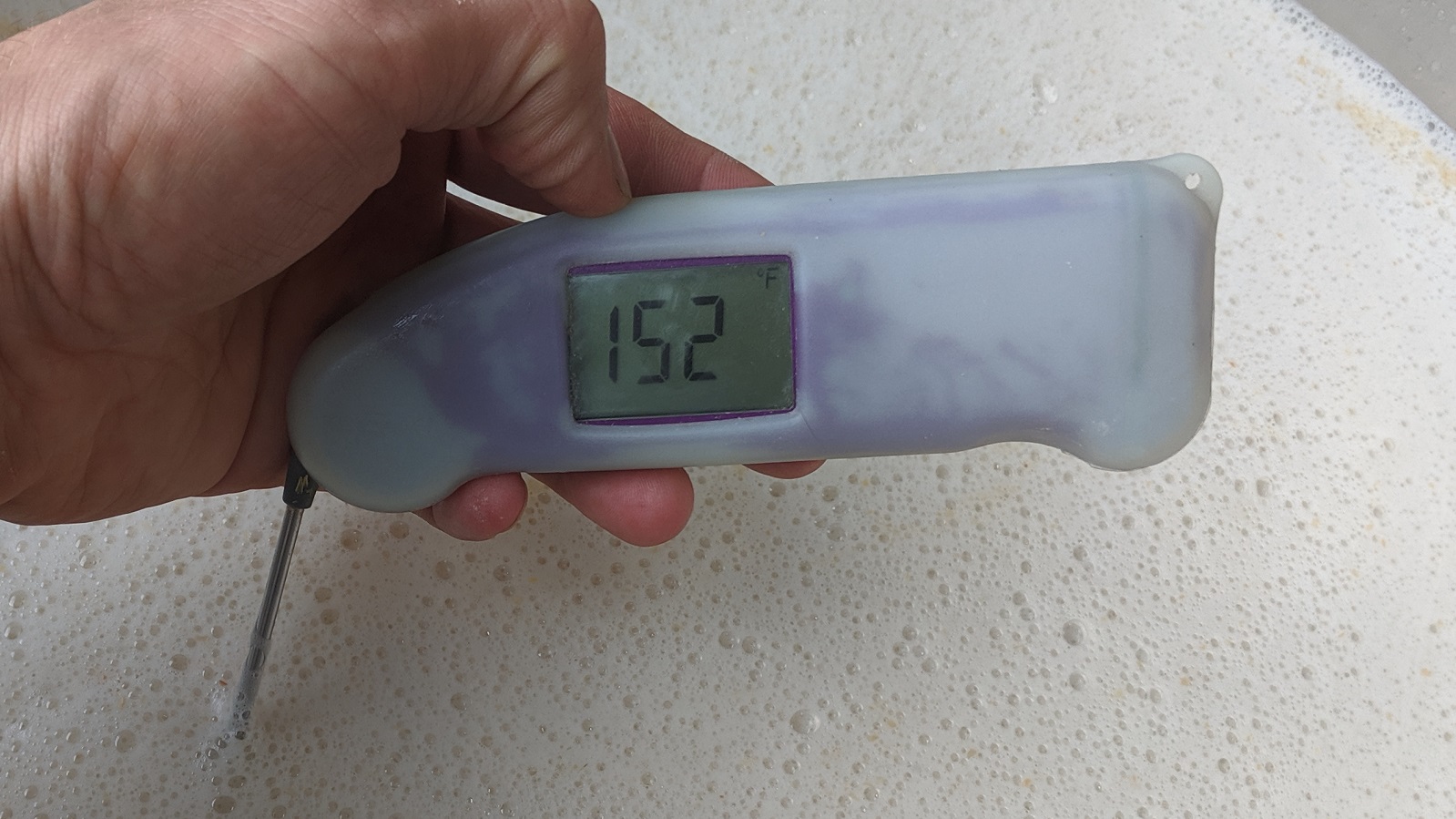
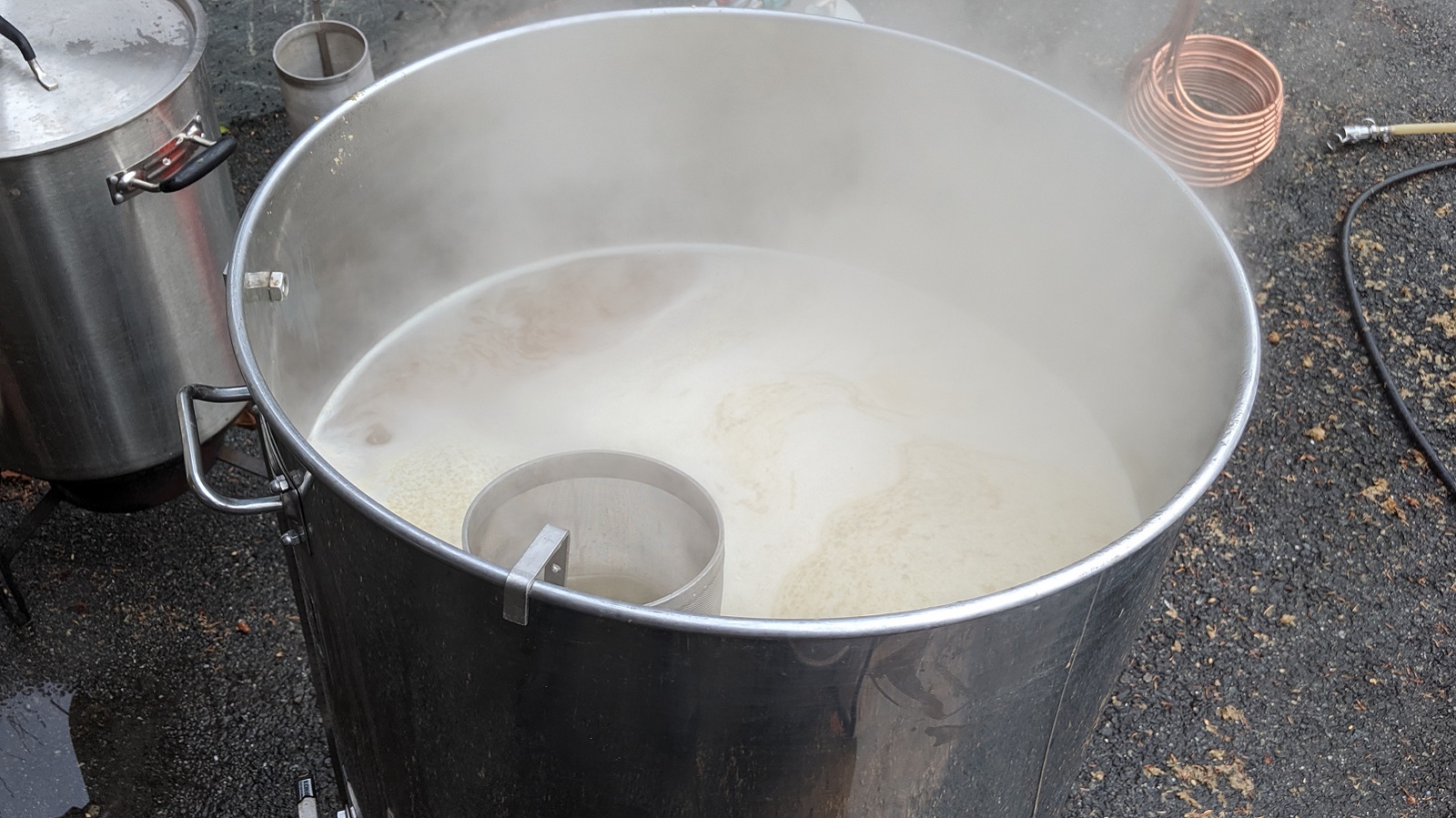
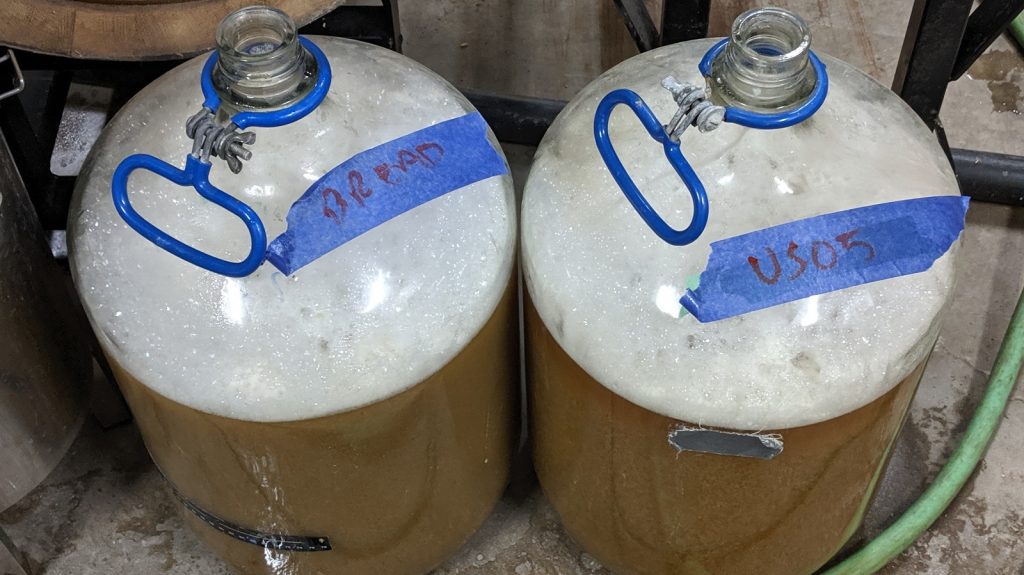
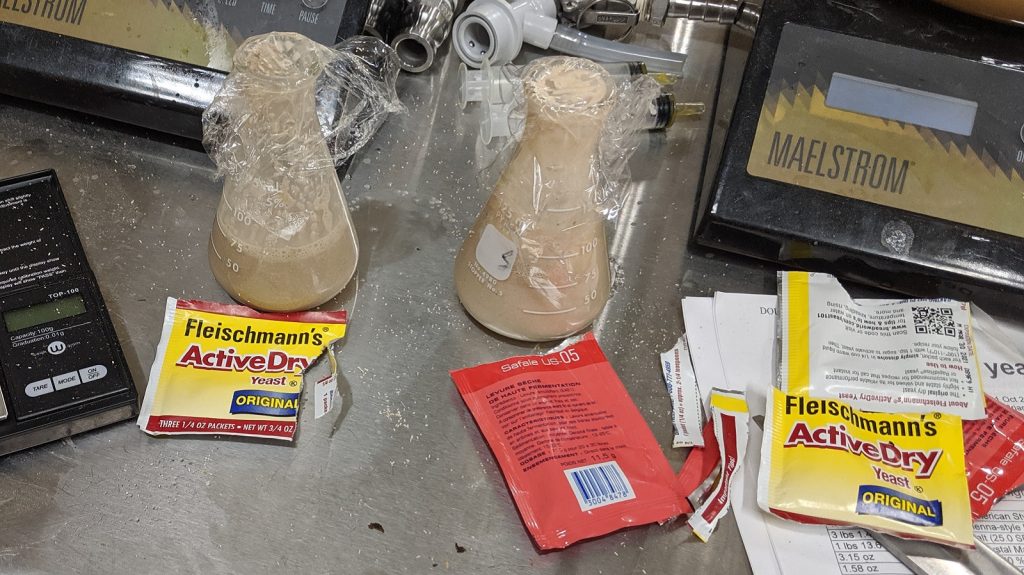











33 thoughts on “exBEERiment | Yeast Comparison: Fleischmann’s Active Dry Yeast vs. Safale US-05 American Ale Yeast”
I’d like to see this tried the other way- Baking bread with US-05
expensive bread
I’ve baked bread with saison yeast before and it performed well.
same
My wife once made donuts using some half-pack leftover BE-134 yeast because she found it in the fridge and knew I wasn’t going to use it anymore. She said the dough rose more than before. The donuts tasted the same, obviously 🙂
That would be so cool!
Nice experiment!
Btw, I think you guys have a wrong “Purpose” section that made its way in there.
Great stuff and thanks for the content.
I too like to bake bread. So, what about using brewers yeast to ferment bread?
I mix yeast post-ferment into my sourdough starter from time to time (and use spent barley in my bread, too) and the results are great. I do it whenever the starter seems to be slowing down. I suppose I could achieve the same result with regular baking yeast, but it’s more fun to use my beer yeast.
Excellent experiment, I had been very curious about Fleischmann’s in beer for a while!
Now, would you please compare a loaf of bread risen with US-05 to a loaf made with Fleischmann’s?
I love this!
Did you reverse the FG results between these beers? I don’t understand US-05 ending at 1.015 given the recipe and process and others experience with this recipe. When combined with your mention that the US-05 batch came out “a bit muddled with lacking enthusiasm” I am wondering if something went wrong with that batch.
I can see not wanting to repeat this experiment given you ended up with two kegs of not so great APA but not sure it makes sense to report that you detected a difference when the control beer (the US-05 batch) didn’t perform as expected/previously experienced.
When I was in Saudi Arabia for Desert Shirl/Desert Storm I got my hands on some bread yeast and pure grape juice from a local canteen. Wasn’t the best “wine” but it did in a pinch in a dry country.
That is resourceful. Thank you for your service!
When I tried using Fleishmanns I got same phenolics that you described. But what I observed was that lag time was way faster compared using US-05. Have you noticed something like this in your batches?
Then I tried to bake using US-05 (DO NOT DO THIS BRIAN 😉 ). Turn out great but this time the lag phase to rise the dough was way longer using 05 compared when using Fleishamnns.
Good exp. I am curious if there was any observable differences between lag times of when fermentation began btwn the 2 batches. Cheers!
Nice one Brian! Not that I want you to do another bread yeast xbmt, lm curious if the bread yeast would not have produced a phenolic if fermented warmer or cooler? I know nothing about baking bread but always thought bread yeast liked it warm? Maybe the bread yeast is from Belgian descent. Very cool xbmt and cool to see you can actually make beer even though it wasn’t great. The bread xbmt seems very interesting. Cheers.
I did the exact same comparison with Redstar active dry yeast vs Safale 05 in March 2016.
Mainly because I bought a 2 lb brick from Costco for $4.50 and the 11 oz pack of Safale 05 from the HBS was $4.00, figured what the hell, couldn’t be that bad.
I split a 5.5 gallon batch of a light pale ale into two different fermenters. The Redstar showed faster more aggressive fermentation and attenuated to a lower FG than 05, 1.006 vs 1.010.
I had five friends come over and try both beers. General consensus was that the Redstar left an aftertaste on the back of your tongue. Two guys liked it, the others preferred the 05 yeast.
If I was stuck and didn’t have any yeast available, I would use it again. I also think I could cover up the aftertaste with more hops.
Sorry, 11.5 g pack of US-05
Ironically, given our current zombie apocolpyse scenario, it’s the bread yeast that everyone’s out of (I’ve given out part of my bag of Safale Red Star bread yeast to two different people in the last week) while US–05 is still shipping 1 day delivery on Amazon. So maybe the calls for backwards “bread with ale yeast” exbeeriment are timely 😉
I would be interested to see if you could make multiple starters using bulk store bakers yeast.
The yeast is often used for simple home recipes for ginger beer or other easy fermentation.
Given that the largest complaint about these yeasts is the lack of consistency I am curious if you could split a scoop of the bulk yeast into 4 starters which may produce different profiles; or possibly one scoop from multiple stores could be used.
Old timer told me back in the prohibition days they would mix a can of LME with water and float a slice of bread with a teaspoon of yeast on it to make “Beer”. Tasted bad he said but it had a kick.
When I tried using Fleishmanns I got same phenolics that you described. But what I observed was that lag time was way faster compared to US-05. Have you noticed something like this in your batches?
Then I tried to bake using US-05 (DO NOT DO THIS BRIAN 😉 ). Turn out great but this time the lag phase to rise the dough was way longer using 05 compared when using Fleishamnns.
Very timely exbeeriment, what with everyone baking bread at home these past two weeks. Being a professional baker and an avid homebrewer, this has always been on my mind but can’t say I’ve ever tried it. Commercial baking yeast has been selected for its short lag time in dough and with little regard for the flavors it produces. These results just confirmed my suspicions that bakers yeast could do the job, but aren’t really worth it.
Brian, I’m curious how your beer fermented with sourdough starter turned out. I was actually planning on trying this myself later this week. I know people have done it, but there’s not much info available online. I did see this posted a couple weeks ago, which is the recipe that I’m going to try.
https://beerandbrewing.com/editors-notebook-brewing-with-sourdough-culture-at-scratch/
I have a hefe that I’m bottling Saturday. No more bakers yeast at the store, however, I cam across several recipes for Ale-Barm Bread. Going to use the trub to make some bread.
Always fun to use bread yeast. Joe’s Ancient Orange Mead is a classic over at homebrewtalk and I don’t know about you but my friends and I definitely experimented with bread yeast and juice when we were teenagers.
Also did you notice any differences in flocculation? That is a big sticking point I’ve read about: baker’s yeast is notorious for never settling or when it does the cake is easily stirred up. Did you have that experience?
I’ve used baker’s yeast for some ciders and meads, after transferring the mead off the yeast cake in a 2nd vessel it stood for about 5 days and started clearing up really nicely, moved to a 3rd vessel(bottle) and after a day it was crystal clear with a minimal yeast formation at the bottom, still wouldn’t recommend shaking the bottle too much.
I kicked off a sourdough starter with WLP 001 about a year ago and it has worked the same as any other sourdough I have used. Have made many great loaves with it, nothing different about the taste or behavior. Now I want to try and brew with the sourdough starter.
When I googled for this article, I was more interested in questions like how caking agents e.g. sodium sorbate interact with beer and what comes out of it. Logically what you get is never what you looking for but still an informative read.
I’ve been catching up on podcasts and listened to last fall’s episode for this exBEERiment a couple of days ago. When I heard about the FG differences, I wondered if the lower FG for the brewers yeast be due to it being a diastaticus strain. As far as applicability of brewers yeast for homebrewing, in addition to kveik strains, I’ve read that some farmhouse ales in Norway are brewed with bakers yeast
An interesting experiment, but Fleischmann’s is probably not a bread or brewer’s yeast, but a distiller’s yeast. Fast, high-temperature, high alcohol tolerance, hence the lower FG compared to the US-05. Fleischmann’s recommends 100°F to 110°F for its yeast to do the job.
My father worked at CCPC when they were making Fleischmann’s Vodka, and he said they were using the Fleischmann’s yeast. Sazerac may still be using Fleischmann’s or its descendant in the Barton (and other) brands.
The working temperature and alcohol tolerance are so similar… I wonder how it compares to a Kveik?
US 05 makes a cool pizza dough , just takes longer to Rise